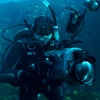Other Names
- Southern Argonaut
- Knobby Argonaut
General Description
The males and females of this free-swimming octopus look very different. The female lives in a white paper-thin shell (often called a "paper nautilus") that reaches around 27 cm long. The female reaches about 27 cm long. The common name of this octopus comes from the knobbed ridges across the sides of the shell. The female has a round body and eight arms, each with two rows of suckers. The first arm pair has two wide webs at the ends. These webs both secrete the white shell and are spread over the outside of the shell when the animal is swimming. The webs can change colour from silver to dark maroon red. The male is much smaller, being less than 3 cm long. It has no shell, a rounded body and large eyes. It has eight arms each with two rows of suckers. The third left arm is much longer and highly modified. It develops in a pouch that reaches around the same size as the body. Female mantle length to 9 cm, total length to 27 cm, shell diameter to 27 cm. Male mantle length to 14 mm, total length to 3 cm.
Biology
This pelagic octopus spends its entire life in open-ocean. Very little is known about the biology of this species. Like other argonaut species it is presumed to feed on pelagic molluscs (particularly heteropods and pteropods), small fishes and crustaceans. Mating in argonauts is very unusual. When a tiny male argonaut encounters a female he ruptures a pouch containing a special reproductive arm. He loads this arm with sperm, detaches it and passes it to the female. Once the arm is shed it is believed that the male argonaut dies. The detached arm crawls into the gill cavity of the female where it attaches to her gills and is stored until it is required for fertilisation. Single females have been found with the arms of multiple males attached to their gills. Eggs are laid in strings attached to the inner core of the female's shell and protected until they hatch. Hatchlings are transparent and are often full of yolk, providing their first meals as they disperse and start fending for themselves. Large swarms of this argonaut wash ashore at irregular intervals along the southern Australian coast. There appears to be no set cycle in these mass strandings with currents, winds, krill schools and lunar cycles all being speculated as the causes. Beach washed shells are popular in the shell trade. Word quickly spreads when strandings occur with some collectors picking up hundreds of shells in a night.
Habitat
Surface waters of open-ocean, may be found in shallow coastal waters or stranded on the beach following periods of onshore winds. Shelled females to approximately 10 m, males and juvenile females to at least 150 m.
Open water
Distribution guide
Southern Hemisphere waters. Southern Australia including Victoria.
Species Group
Octopuses and allies › Argonauts
Depth
Shore (0-1 m)
Shallow (1-30 m)
Deep ( > 30 m)
Water Column
Max Size
3 cm
Diet
Carnivore
Harmful
Potential to bite, especially if handled. Venom status unknown.
Commercial Species
No
Global Dispersal
Native to Australia
Identify
Conservation Status
- DSE Advisory List : Not listed
- EPBC Act 1999 : Not listed
- IUCN Red List : Not listed





